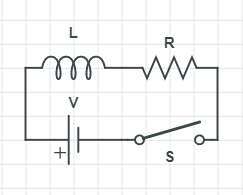
An inductor of inductance $L=\dfrac{\tau R}{2}$ and a resistor of resistance $R$ is connected to a battery of emf $V$ as shown in the figure. The potential difference across the resistance at a time $t=\tau ln2$ after the switch $S$ is closed is $k\;V$ . Find the value of $k$ ($\tau$ is constant)


Answer
575.4k+ views
Hint: Here, we have an LR series circuit, to find the potential difference across $R$ at some time $t$, we need to first calculate the total current in the circuit at any time, and then find the potential difference across the resistance $R$. then if we substitute the value of $t$ and equate the answer to $k\;V$, we can find the value of $k$.
Formula used:
$i=\dfrac{V}{R}\left(1-e^{-\dfrac{Rt}{L}}\right)$
Complete step by step answer:
Let $i$ be the current in the circuit, clearly it depends on the time, as there is an inductor in the circuit. Then the total current is expressed as $i=i_{r}+(i_{r}-i_{i})e^{-\dfrac{Rt}{L}}$.
Where, $i_{r}$ is the current flowing through the resistor$R$, $i_{l}$ is the current flowing through the inductor $L$ in time $t$.
Also $\tau$ is the time constant and it is given as $\tau=\dfrac{L}{R}$
Here, it is given that, inductance $L=\dfrac{\tau R}{2}$, resistance is$R$and an emf $V$is applied to the circuit, then from ohm’s law, we can write the $i_{r}=\dfrac{V}{R}$.
If $i_{i}=0$, then we get, $i=\dfrac{V}{R}-\dfrac{V}{R}e^{-\dfrac{Rt}{L}}=\dfrac{V}{R}\left(1-e^{-\dfrac{Rt}{L}}\right)$
$\implies V_{r}=V\left(1-e^{-\dfrac{Rt}{L}}\right)$, where $V_{r}$ is the voltage across the resistance $R$ and is given as,$V_{r}=iR$
From, $L=\dfrac{\tau R}{2}$
Rearranging, we get,$\dfrac{L}{R}=\dfrac{\tau}{2}$
Substituting, in the above, we get, $V_{r}=V\left(1-e^{-\dfrac{2t}{\tau}}\right)$
We need to find the potential difference across the resistance at a time $t=\tau ln2$ , hence substituting for in the above equation,
we get, $V_{r}=V\left(1-e^{-\dfrac{2\tau ln2}{\tau}}\right)$
$\implies V_{r}=V\left(1-e^{-2ln 2}\right)$
$\implies V_{r}=V\left(1-e^{-ln 4}\right)$
$\implies V_{r}=V\left(1+4\right)$
$\implies V_{r}=5V$
Given that $V_{r}=kV$
Then, we get $kV=5V$
$\implies k=5$
Hence the value of $k$ is $5$
Note:
$\tau$ is the value at which $\dfrac{V}{R}$ is the final steady state current flowing through the circuit, it is reached at $5\tau$. Also, after reaching this steady state current, the inductance of the coil reduces to zero. In a charging circuit, $5\tau$ is called the transient time of the circuit.
Formula used:
$i=\dfrac{V}{R}\left(1-e^{-\dfrac{Rt}{L}}\right)$
Complete step by step answer:
Let $i$ be the current in the circuit, clearly it depends on the time, as there is an inductor in the circuit. Then the total current is expressed as $i=i_{r}+(i_{r}-i_{i})e^{-\dfrac{Rt}{L}}$.
Where, $i_{r}$ is the current flowing through the resistor$R$, $i_{l}$ is the current flowing through the inductor $L$ in time $t$.
Also $\tau$ is the time constant and it is given as $\tau=\dfrac{L}{R}$
Here, it is given that, inductance $L=\dfrac{\tau R}{2}$, resistance is$R$and an emf $V$is applied to the circuit, then from ohm’s law, we can write the $i_{r}=\dfrac{V}{R}$.
If $i_{i}=0$, then we get, $i=\dfrac{V}{R}-\dfrac{V}{R}e^{-\dfrac{Rt}{L}}=\dfrac{V}{R}\left(1-e^{-\dfrac{Rt}{L}}\right)$
$\implies V_{r}=V\left(1-e^{-\dfrac{Rt}{L}}\right)$, where $V_{r}$ is the voltage across the resistance $R$ and is given as,$V_{r}=iR$
From, $L=\dfrac{\tau R}{2}$
Rearranging, we get,$\dfrac{L}{R}=\dfrac{\tau}{2}$
Substituting, in the above, we get, $V_{r}=V\left(1-e^{-\dfrac{2t}{\tau}}\right)$
We need to find the potential difference across the resistance at a time $t=\tau ln2$ , hence substituting for in the above equation,
we get, $V_{r}=V\left(1-e^{-\dfrac{2\tau ln2}{\tau}}\right)$
$\implies V_{r}=V\left(1-e^{-2ln 2}\right)$
$\implies V_{r}=V\left(1-e^{-ln 4}\right)$
$\implies V_{r}=V\left(1+4\right)$
$\implies V_{r}=5V$
Given that $V_{r}=kV$
Then, we get $kV=5V$
$\implies k=5$
Hence the value of $k$ is $5$
Note:
$\tau$ is the value at which $\dfrac{V}{R}$ is the final steady state current flowing through the circuit, it is reached at $5\tau$. Also, after reaching this steady state current, the inductance of the coil reduces to zero. In a charging circuit, $5\tau$ is called the transient time of the circuit.
Recently Updated Pages
A man running at a speed 5 ms is viewed in the side class 12 physics CBSE

State and explain Hardy Weinbergs Principle class 12 biology CBSE

Which of the following statements is wrong a Amnion class 12 biology CBSE

Two Planoconcave lenses 1 and 2 of glass of refractive class 12 physics CBSE

The compound 2 methyl 2 butene on reaction with NaIO4 class 12 chemistry CBSE

Bacterial cell wall is made up of A Cellulose B Hemicellulose class 12 biology CBSE

Trending doubts
What are the major means of transport Explain each class 12 social science CBSE

Which are the Top 10 Largest Countries of the World?

Draw a labelled sketch of the human eye class 12 physics CBSE

Explain sex determination in humans with line diag class 12 biology CBSE

Give 10 examples of unisexual and bisexual flowers

State the principle of an ac generator and explain class 12 physics CBSE




